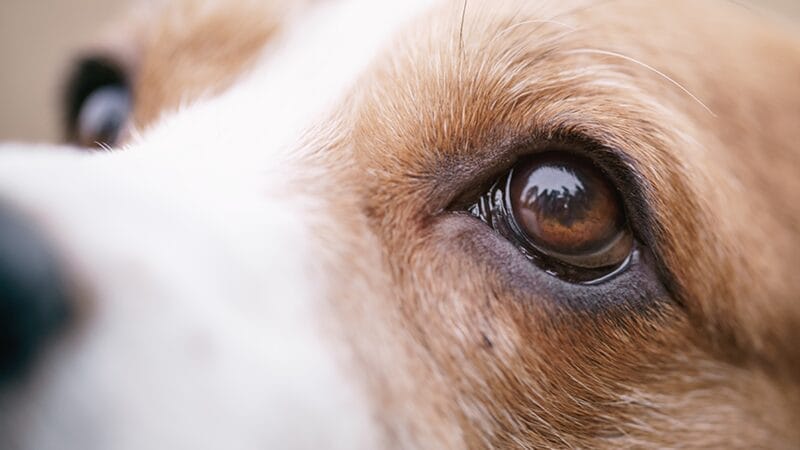Understanding Your Pet’s Eyes: Normal vs. Abnormal Signs and Care Tips
Recognizing what is normal and what is not for pets’ eyes can help pet owners identify and address potential health issues.
If you’re familiar with the expression “You’re giving me those puppy eyes,” you know it describes the affectionate way dogs look at humans. Those charming eyes of dogs, and cats too, are not just expressions of love; they also provide insights into their health. Recognizing what is normal and what is not for their eyes can help us ensure our pets remain healthy and content. Let’s explore how the eyes of dogs and cats’ function and examine the signs and treatments of common eye conditions affecting them.
How Dogs’ Eyes Work and Their Differences from Humans
Dogs’ eyes have several adaptations that make them unique. Structurally, a dog’s eyes are positioned to provide a wider field of view, allowing them to spot movement from the sides more efficiently. This is particularly useful for their ancestral hunting activities.
One significant difference is the presence of a third eyelid, known as the nictitating membrane, which helps protect the eye, contribute to tear production, and distribute tears. Dogs also have a reflective layer behind the retina called the tapetum lucidum, which enhances night vision by reflecting light back through the retina.
However, dogs have fewer cone cells in their eyes compared to humans, which means they don’t see colors as vividly, but they have more rod cells, which are more sensitive to light and motion. This adaptation is important for their ability to detect movement in low light conditions, giving them an advantage during dawn and dusk when many of their natural prey are active.

How Cats’ Eyes Work and Their Differences from Humans
Cats’ eyes are highly specialized for nocturnal activity. Like dogs, cats have the tapetum lucidum, which improves their ability to see in low light. Their vertical pupils can open and close dramatically to allow just the right amount of light in, protecting the sensitive retina at the back of the eye.
Cats have a higher number of rods in their retinas than humans do, which enhances their dim light vision. Their color vision is similar to dogs, where it is believed that they see shades of blue and green best. This color perception is sufficient for their hunting needs, especially under low light conditions.
Signs Pet Owners Should Be Aware of for Their Pets’ Eyes
Pet owners should regularly check their pets’ eyes for any signs of abnormality, including:
- Redness or inflammation: This could indicate infections or allergies.
- Discharge: Green or yellow discharge can be a sign of infection.
- Cloudiness or change in eye color: This could suggest cataracts or other serious issues.
- Frequent blinking, squinting, or pawing at the eyes: This can be a sign of discomfort or foreign objects in the eye.
- Poor vision: Bumping into objects or reluctance to jump or climb can indicate vision problems.

Common Eye Conditions in Pets and Their Treatments
Several conditions can affect pet eyes, each with specific treatments:
- Conjunctivitis: This condition occurs when the lining of the eyelids and sclera (the white of the eye) become inflamed. The Inflammation can be caused by infection, an allergic reaction, a foreign object in your pet’s eye, or environmental factors like smoke or dust. Treatment depends on the cause, but it may include eye drops or ointments prescribed by a veterinarian.
- Cataracts: When a pet experiences opacity (cloudiness) in the lens of their eye, they have cataracts. Cataracts cause blurred vision in pets and is the most common cause of blindness in dogs. Treatment may include surgery to remove the lens and allow light to enter the eye again. The natural lens is often replaced by an artificial lens. Learn more about the surgery through this video.
- Glaucoma: Increased pressure in a pet’s eye is glaucoma and immediate veterinary treatment is needed to prevent vision loss as glaucoma in pets can damage the retina or optic nerve. Glaucoma treatment for pets can include surgery, medications, and eye drops.
- Dry Eye (Keratoconjunctivitis sicca): Dry eye occurs when your pet doesn’t produce enough tears to keep their eyes properly lubricated. Dogs and cats may experience dry eye from an injury, an immune system reaction, or as a side effect from a medication. Dry eye in pets is often treated with medications that stimulate tear production or artificial tears.

How Pet Owners Can Take Care of Their Pets’ Eyes
Maintaining your pet’s eye health involves regular care and monitoring:
- Regular check-ups: Include eye exams in your pet’s regular veterinary check-ups. Your family veterinarian may refer you to a veterinary ophthalmologist for specialty care.
- Keep face fur trimmed: Especially in breeds with longer hair, keeping the fur around the eyes trimmed can prevent irritation.
- Clean eyes gently: Use a soft, damp cloth and baby shampoo to wipe away any dirt or discharge around the eyes. Some dogs, particularly those who are white or light-colored, may have noticeable tear staining around their eyes. This is normal and comes from porphyrin, iron-containing molecules produced by the body when it breaks down iron. Porphyrins are excreted through the gastrointestinal tract, urine, saliva, and tears.
- Protect their eyes: When using shampoos or applying flea treatments, be careful to avoid the eye area.
Understanding how your pet’s eyes work and what is normal or not can help you spot potential issues early. Regular veterinary care and some simple daily practices can ensure that your pet’s eyes remain bright and healthy.
Learn more about veterinary ophthalmology.
FAQs
Learn More
Regular eye check-ups for your pet help maintain their eye health and detect any potential health issues.
Veterinary OphthalmologyContents
Learn More
Regular eye check-ups for your pet help maintain their eye health and detect any potential health issues.
Veterinary Ophthalmology


